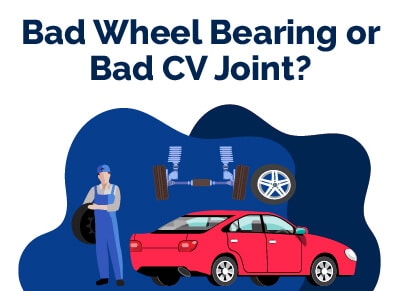Top 4 Differences Between Bad Wheel Bearings and Bad CV Joints
February 28, 2024


I am a serial entrepreneur and a consumer advocate. When I’m not helping car buyers, I love working on ventures that have a positive impact.
I run a cause marketing agency and serve on the board of Vayu Global Health where we are disrupting the medical industry and preventing the needless deaths of mothers and babies during childbirth.
How do you know if you have a bad wheel bearing or a bad CV joint? One of the easiest ways to tell the difference between a bad wheel bearing and a bad Constant Velocity (CV) joint is to listen to the noise.
Bad wheel bearings produce a loud rumbling noise, especially when your wheels roll. On the other hand, bad CV joints produce clicking, clunking noise. The noise can become louder when you are turning.
However, noise diagnosis is not the only way to investigate this issue. You have other diagnostic methods like physical inspections and performance symptoms.
Our expert editors have been right where you are and have compiled all you need to know for this fix. We know that properly diagnosing the symptoms can save you time and money on repairs, ensuring your vehicle remains in top condition.
Let’s discuss how to tell the difference between a bad wheel bearing and a bad CV joint and so much more.
Table of Contents
- Bad Wheel Bearing or CV Joint Video
- How To Tell the Difference Between Bad Wheel Bearing and Bad CV Joint
- Why It’s Important To Distinguish Between a Bad Wheel Bearing and CV Joint
- Preventive Maintenance Tips for Wheel Bearings and CV Joints
- Older Vehicles vs. Modern Vehicles: Wheel Bearings and CV Joints
- Professional vs. DIY Repair Guidance for Wheel Bearings and CV Joints
- Verdict
- Best Car Deals by Category
- Frequently Asked Questions
Bad Wheel Bearing or CV Joint Video
How To Tell the Difference Between Bad Wheel Bearing and Bad CV Joint
Here are four easy ways to differentiate between a bad wheel bearing and a bad CV joint.
1. Noise diagnosis
The first way to know if you have a bad wheel bearing or bad CV joint is to check the type of noise they make. The noise diagnosis for this extends to discovering the source of the noise.
Wheel bearings are located at the wheel hub, while CV joints are located at the drive shaft. With the location of these parts, they will produce different noises from different areas.
To tell if you have a bad wheel bearing or bad CV joint, identify if the noise is coming from inside or outside the car. A bad wheel bearing will produce noise from under your vehicle because it emanates from the wheels. Bad CV joints come from outside the car.
Another way to tell is to analyze the type of noise they make. Bad CV joints make clicking noises, while bad wheel bearing produces grinding, rumbling, or growling noises.
2. Understanding the symptoms of a bad wheel bearing
Understanding what happens when a wheel bearing goes out will help determine if it is a bad wheel bearing or a bad CV joint. So how do you diagnose a bad wheel bearing? By simply getting familiar with bad wheel-bearing symptoms.
Many symptoms indicate that you have a bad wheel bearing. Identifying these symptoms is one of the easiest ways to confirm that you have a bad wheel bearing.
Some of the common symptoms of a bad wheel bearing that you should look out for include:
- Unusual noise; grinding, rumbling, or growling noise
- Play in wheels
- Uneven tire wear
- Vibration in steering wheels
3. Understanding the symptoms of a bad CV joint
To tell the difference between a bad wheel bearing and a bad CV joint, you should know what happens if your CV joint goes out. Identifying any common bad CV joint symptoms should tell you that you have a bad CV joint and not a bad wheel bearing.
Some of the common symptoms of a bad CV joint that you should look out for include:
- Popping or clicking noise
- Vibration while driving
- Car pulls to one side
- Wheels stop turning, or the car won’t move
- Grease on the edge of your tires or inside your wheels
4. Effects of driving on both bad elements
Bad CV joints and wheel bearings produce different effects on a car. Driving with a bad wheel bearing will cause your wheels to wobble while driving on a bad CV joint will cause strong vibrations on the wheels.
In extreme cases, a bad CV joint will cause your car to pull to one side because one side of your wheels is losing power. This is because the corresponding wheels or tires are disconnected from the drive axle. In the case of a bad wheel bearing, your steering wheel will vibrate, and there will be uneven tire wear.
Why It’s Important To Distinguish Between a Bad Wheel Bearing and CV Joint
Distinguishing between a bad wheel bearing and a bad CV (Constant Velocity) joint is crucial for several reasons, each directly impacting vehicle safety, performance, and the cost and scope of repairs:
- Safety: Both components are integral to the vehicle's drivetrain and wheel systems. A failure in either part can lead to significant safety risks. For example, a bad wheel bearing can cause the wheel to wobble or even detach from the vehicle at high speeds, while a failed CV joint may lead to a loss of power to the wheels and potentially cause the vehicle to stop unexpectedly. Identifying which component is failing allows for timely repairs that prevent dangerous on-road situations.
- Accurate Diagnosis and Repair: Misdiagnosing a bad wheel bearing for a bad CV joint, or vice versa, can lead to unnecessary repairs, wasting time and resources. Each has distinct symptoms and repair procedures. For instance, a wheel bearing issue might present as a humming or grinding noise that gets louder with speed, while a CV joint problem might manifest as clicking noises during turning. Correct diagnosis ensures the right repair approach, avoiding further damage to the vehicle.
- Performance: Both the wheel bearing and CV joint play critical roles in the vehicle's handling and smoothness of the ride. A bad wheel bearing can lead to uneven tire wear, poor alignment, and diminished handling, while a faulty CV joint affects the transmission of power to the wheels, leading to performance issues. Understanding which part is malfunctioning helps maintain the vehicle's performance by addressing the specific problem.
- Cost Efficiency: Repair costs for wheel bearings and CV joints can vary significantly. Knowing exactly which component needs attention helps in planning the repair work more cost-effectively. Unnecessary replacements or repairs can be avoided, ensuring that only the affected parts are addressed.
- Preventive Maintenance: Recognizing the difference between these failures can also inform better preventive maintenance strategies. For example, a CV joint's failure is often due to a broken CV boot, which can be caught and replaced early. In contrast, wheel bearings may fail due to natural wear and tear or improper installation. Identifying the specific issues can lead to more focused maintenance efforts, potentially extending the life of these components.
Preventive Maintenance Tips for Wheel Bearings and CV Joints
Maintaining your vehicle's wheel bearings and CV joints is crucial for ensuring its longevity and safety. Regular preventive maintenance can help you avoid the inconvenience and costs associated with their failure. Here are some essential tips to help you keep these critical components in top condition:
Regular Inspection
- Wheel Bearings: Check for signs of wear and tear or damage during routine vehicle inspections. Listen for noises or feel for play in the wheels during tire rotations, as these can be early indicators of bearing issues.
- CV Joints: Inspect the CV boots for cracks, tears, or leaks regularly. The boots protect the CV joints from dirt and moisture, and any damage can lead to premature joint failure.
Lubrication
- Ensure that your wheel bearings are properly lubricated according to the manufacturer's specifications. For vehicles with serviceable wheel bearings, repack them with high-quality grease every time you service the brakes.
- While most modern CV joints are sealed and do not require regular lubrication, ensuring the integrity of the CV boots is vital to keep the joints lubricated and functioning.
Avoid Excessive Loads
Avoid overloading your vehicle beyond its recommended capacity. Excessive weight can put additional strain on wheel bearings and suspension components, accelerating wear.
Drive Carefully
- Driving habits significantly affect the longevity of wheel bearings and CV joints. Avoid potholes, curbs, and other impacts that can cause immediate damage or contribute to faster wear.
- Take turns and corners at a moderate speed to reduce the stress on CV joints during turning maneuvers.
Promptly Replace Damaged Boots
If a CV boot is damaged, replace it as soon as possible to prevent dirt and moisture from entering the joint, which can lead to premature failure. In some cases, it may be cost-effective to replace the entire CV joint or axle if damage has occurred.
Use High-Quality Replacement Parts
When replacements are necessary, opt for high-quality bearings and CV joints. Cheaper alternatives may not meet OEM specifications and can fail prematurely.
Follow the Manufacturer’s Maintenance Schedule
Adhere to your vehicle's maintenance schedule as recommended by the manufacturer. Regular service appointments are an opportunity for professionals to inspect wheel bearings, CV joints, and other critical components.
Listen to Your Vehicle
Be attentive to the sounds and behaviors of your vehicle. Grinding, clicking, or popping noises can all indicate potential issues with wheel bearings or CV joints. Addressing these symptoms early can prevent more significant problems down the road.
Older Vehicles vs. Modern Vehicles: Wheel Bearings and CV Joints
Older vehicles often feature serviceable wheel bearings that are designed for regular maintenance, including cleaning and greasing. In contrast, modern vehicles typically utilize sealed wheel bearings, which are maintenance-free but need complete replacement upon failure.
Similarly, CV joints in older cars may have simpler designs and could require more frequent inspections and maintenance. Modern vehicles, however, benefit from advanced CV joint technologies that offer enhanced durability and are often part of sealed units, reducing the need for service but necessitating full replacement if issues arise.
Professional vs. DIY Repair Guidance for Wheel Bearings and CV Joints
When it comes to repairing or replacing wheel bearings and CV joints, vehicle owners often contemplate whether to undertake the task themselves or seek professional assistance. Here's a brief guide to help you decide:
DIY Repair Considerations
- Skill Level: DIY repairs are suitable for those with a moderate to high level of mechanical skill and understanding of their vehicle's suspension and drivetrain systems. Basic tasks like inspecting or replacing CV boots might be manageable for most, but more complex repairs require detailed knowledge and experience.
- Tools and Equipment: Proper tools are essential for DIY repairs. For wheel bearings and CV joints, this might include a jack and jack stands, torque wrench, socket set, and possibly a bearing press or puller. Ensure you have the right equipment and safety gear before starting.
- Cost Savings: The primary advantage of DIY repairs is the potential for cost savings on labor. However, consider the cost of tools and parts, as well as the value of your time.
- Time Commitment: Depending on your experience, a DIY repair can take significantly longer than professional service. Assess whether you have the necessary time and patience.
When To Choose Professional Service
- Complexity of Repairs: Some wheel bearing and CV joint repairs can be complex and require specialized tools or expertise. For example, pressing a bearing into a hub or diagnosing specific issues might be better left to professionals.
- Warranty and Reliability: Professional repairs often come with a warranty on parts and labor. If you're not confident in your ability to perform the repair to a high standard, professional service can offer peace of mind.
- Safety Considerations: Incorrectly repaired or improperly installed wheel bearings or CV joints can lead to serious safety issues. If you're unsure about any part of the repair process, it's best to rely on professional mechanics who are trained to handle these tasks safely and efficiently.
- Time Efficiency: A professional mechanic can typically complete repairs more quickly than the average DIYer, minimizing vehicle downtime.
Making the Decision
Consider the complexity of the repair, your own skill level, the tools available to you, and the potential cost savings when deciding between DIY and professional repairs. For simple maintenance tasks, DIY might be a viable option. However, for complex repairs, replacements, or when safety is a concern, seeking professional assistance is often the best choice.
Verdict
Diagnosing a bad wheel bearing can be so confusing that you may assume you have a bad CV joint when you don’t. Now that you can tell the difference between a bad wheel bearing and a bad CV joint, what do you do when your CV joint or wheel bearing fails?
It is important that you slowly take your car off the road, hire a tow truck, and visit a professional mechanic immediately.
Your mechanic will decide the extent of the damage and the perfect solution for the problem. It is important that you do not underestimate failures in your CV joint or wheel bearing. They pose a great danger to you and other road users.
Best Car Deals by Category
Frequently Asked Questions
Can transmission fluid leak from the CV joint?
Yes. There is a high chance that transmission fluid will leak from your CV joint. This will only happen if you have a bad CV joint and the fault extends to the entirety of your CV axle.
Do wheel bearings lack oil?
Wheel bearings need proper lubrication to handle friction. It is possible that they can lack oil, but this will happen if you fail to lubricate them properly. You must understand that most sealed bearings come with lubricants packed in the bearing seal.
Can a Bad wheel bearing cause the CV axle to go bad?
Yes. Bad wheel bearings can damage the CV joints and axle. The dangers of driving with a bad wheel bearing are not limited to your CV axle; it can damage your steering system and other components in your car. It can compromise the performance of your car and put your life in danger.
Posted in Car Buying Tips, Car Troubleshooting |




